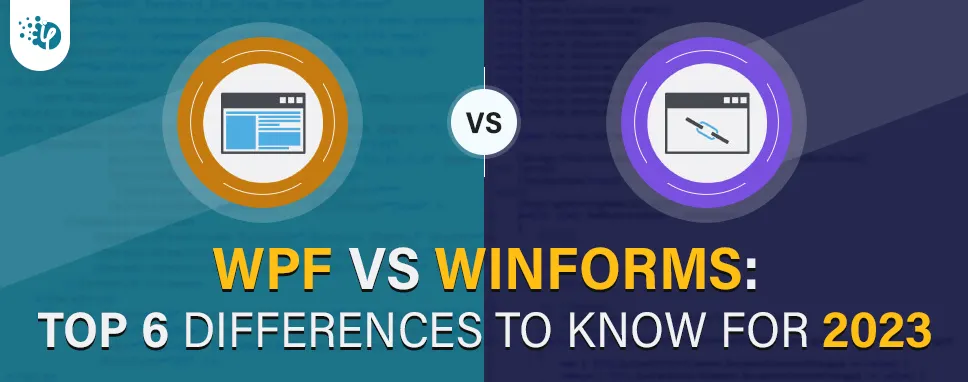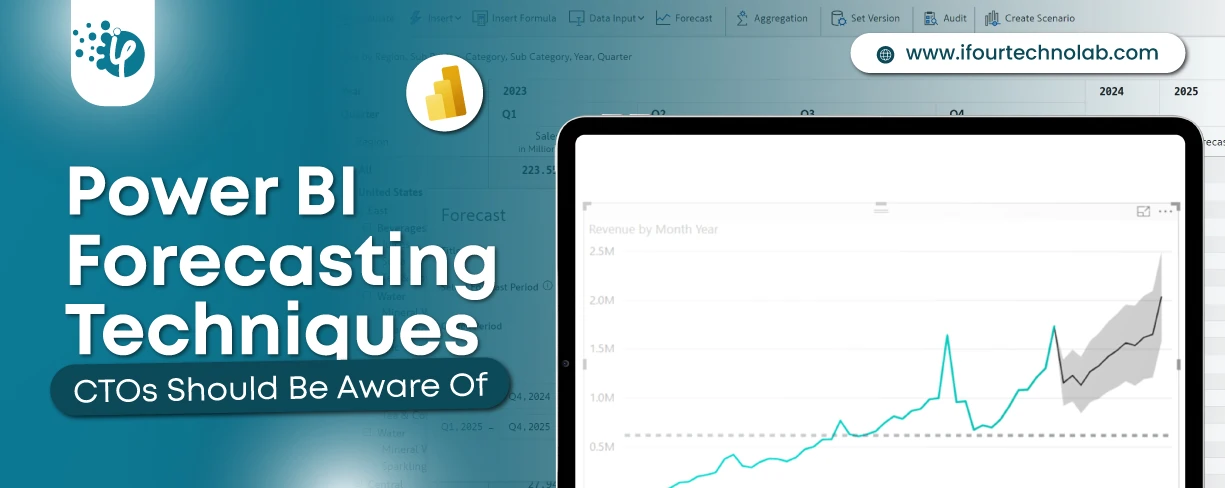How to Do Forecasting in Power BI (Steps & Accuracy Metrics)
Remember our last guide - Power BI forecasting? It revealed things that truly blocks accuracy, both structural and situational. Now it's time to take the next step. Knowing Power...
Listening is fun too.
Straighten your back and cherish with coffee - PLAY !

WPF and WinForms are two excellent Microsoft platforms that made a significant contribution to Windows and desktop app development. Although they both serve the same purpose, the most significant difference to note between them is WPF is not just a layer over the default Windows controls (which is the case in WinForms). Instead, it is one that can be created from scratch and is independent of regular Windows controls. WPF has some incredible features like 2D and 3D animations, media services, styles, typography, graphics, data binding, etc., and uses XAML to declaratively design views.
Many IT companies have chosen WPF as their preferred platform for UI development in Windows and web projects since it was a great upgrade over WinForms. Let’s dive further and understand the most significant differences between WinForms and WPF, and how their features would aid in UI development.
| Feature | WPF | WinForms |
|---|---|---|
| UI Design | WPF is flexible, and customizable with vector-based design support | WinForms is simple and has a control-based design structure. |
| Performance | WPF is typically faster, especially with complex UI | WinForms is slower with complex UIs compared to WPF |
| Development | WPF is more complex and requires XAML knowledge | Windows Forms is easier to learn and use |
| Data Binding | Supports advanced data binding | Basic data binding support |
| Scalability | Better suited for large-scale applications | Suitable for smaller, simpler applications |
| Visual Effects | Rich animations and effects | Limited visual effects |
| Deployment | Requires .NET Framework | Can be deployed with .NET Framework or .NET Core |
Now that you know the basic features of WPF vs Windows Forms, let’s understand which is better, WPF or Windows Forms.
For this, we have listed the major differences between WPF and WinForms given by the subject experts. Check them out here.
WPF and WinForms are both GUI frameworks that can be used to create applications for the Windows operating system. WPF is newer and was created to address some of the limitations of WinForms. The biggest difference between WinForms vs WPF remains is their approach to layout and rendering. WPF uses a layout system based on XAML files, while WinForms uses procedural code or XML files that are compiled at runtime. This means that WPF applications have a declarative layout system that allows you to define what an application should look like without having to write any code—this can make it easier to build complex user interfaces.
Another difference between WPF and WinForms is how they are rendered by the operating system. With WPF, every element in your application is rendered as an object tree in memory; with WinForms, each element is rendered as a native control on top of whatever other controls may already be on the screen (which means there can be conflicts).
Windows Presentation Foundation (WPF) and Visual Basic for Applications (WinForms) are two different development frameworks that can be used to create desktop applications. WPF is a completely new platform that was introduced with the release of Windows 8, while WinForms is an older framework that has been around since 2000.
Originally developed by Microsoft as part of its efforts to develop user interfaces for netbooks and other mobile devices, WPF offers a more fluid and intuitive experience when developing desktop applications compared to traditional Windows-based programming models like .NET Framework 4 or ASP.NET MVC5.
One major advantage of using WPF is its support for vector graphics, making sophisticated interface designs possible without needing additional software tools.
On the downside, WinForms does not offer as much flexibility when it comes to designing your application's user interface, and it can be less responsive than rival platforms such as React Native or HTML/CSS/JS Hybrid apps built with Angular JS or VueJS2 respectively.
Additionally, because WPF runs in a browser rather than on a dedicated Operating System, windows like those made available through WinForms, you may experience performance issues if your app requires significant processing power or lots of graphical resources. In a nutshell, intuitive experience matters when it comes to WinForms vs WPF.
Talking about WPF vs WinForms, one major difference you can notice is – WinForm cannot be shared between applications. As its name suggests, Windows Presentation Foundation (WPF) is a user interface foundation for creating desktop or Windows-based client software. It's the newest method for building user interfaces with the Microsoft .NET framework. It was made to develop Windows Forms, the next generation of Windows-based user interfaces, and Windows Client applications.
It has all the capabilities required to design, operate, execute, manage, and handle Windows client applications. Because of its name, WinForms is primarily a graphical user interface (GUI) based approach to the .NET framework. It was the primary API for .NET GUI development before WPF, and Silverlight came along. Creating a standalone application only necessitates a runtime and operating system.
In Windows forms, the application setting is another feature to create, store, and preserve information. When designing an application framework, you can use Windows form class inheritance to add abstraction and code reuse by extending the class. The size of forms should be restricted for convenience's sake. Assembly files allow records to be broken down into modular pieces that can be updated independently.
The scalability and adaptability of the application are achieved by its layout, which also facilitates debugging and maintenance tasks. Unfortunately, Windows forms cannot be shared between applications. WPF application development may be done with the help of Microsoft technologies like Visual Studio and Expression Blend. The developer often builds WPF applications in Visual Studio, whereas designers choose Blend.
WinForms programming is incredibly easy because it only requires the drag-and-drop placement of UI controls on a canvas. It is the previous platform for creating desktop programs. The architecture of WPF, in contrast to WinForms, consists of three main parts, a presentation framework, a presentation core, and a mallcore. WPF is offered as a standalone solution because it does not totally rely on Standard Windows Controls. Another distinguishing feature of WPF over WinForms is the ability to add a Button with an Image.
WinForms and WPF are both .NET Framework GUI application development features. WinForms is somewhat older and has been entirely supplanted by WPF's XAML-based GUI Framework. This does not imply that WinForms is inferior, as it is quite useful for many project kinds and does not require Blend to create your UI.
The essential question is which option is superior in the case of WPF vs WinForms. In terms of scalability and the ability to migrate from one of these two to, say, Windows Universal Application development, the victor is WPF because the Windows Universal Runtime is also designed with XAML, making the transition from WPF to UWP simpler. WinForms is the clear victor in terms of rapidly prototyping and having a working application. It ultimately depends on your project and the GUI design you choose for your application to determine which one is superior; both are well-maintained and of high quality.
WPF is similar to HTML in that the user interface is defined in an XML file (called XAML) utilizing relative measurements and positioning of items. WPF is easier to use than WinForms, which is a typical user interface (UI) framework. However, you may need to learn about data binding and other concepts before you can use it (everything specified in the code, even if designer-generated). Microsoft Blend, which is similar to Dreamweaver for programs, may be used with WPF.
Windows Forms, or WinForms, is a programming language used to create graphical user interfaces on computers. Simply put, it's a graphical front-end for desktop programs written in the Microsoft .Net development framework. It makes use of the .Net Framework's managed libraries. It provides the interface for accessing the native Windows graphical interface elements and visuals from managed programs via a comprehensive client library.
A Windows presentation framework is known by its acronym, WPF. In 2006, Microsoft introduced it alongside .Net Framework 3.0. It's a GUI framework for creating programs on Windows. WPF is an integral element of the.net framework and not just a wrapper. It is a hybrid, including both managed and unmanaged components. Every control in a Windows form application is a concrete instance of a class, and Windows forms provide a wrapper consisting of this set of C++ classes for building Windows applications.
Numerous pre-built controls, including text areas, buttons, labels, and even whole websites, are available, and the user can even make their own. To manage the form's controls and arrange them in the desired layout for adding code to handle events, Visual Studio provides a Windows form designer tool. The three main parts of the WPF architecture are the presentation framework, presentation core, and mallcore. While XAML is used to create UI elements, a procedural language can be used to implement behaviors in WPF.
WPF's XAML allows developers and designers to collaborate. WPF is a robust framework for developing Windows applications, and it comes with many useful capabilities such as data binding, media services, templates, animations, Direct3D, and alternative input.
WinForms and WPF have greatly influenced the development of Windows and desktop applications. Although they both served the same goal, there were some significant distinctions that made WPF superior to WinForms. WPF has been a framework that endured the test of time and has proven to be a key choice for many tech giants. This blog has covered the key distinctions between WinForms and WPF as well as how each can help with app development.
We also checked out what the experts had to say about WPF versus WinForms and discovered some really helpful insights that make the development process even better!
WinForms and WPF both are Microsoft-designed frameworks consisting of a unique set of strengths and weaknesses. WPF excels in achieving seamless animation and improved graphic quality. While WinForms can be a better option to build lightweight and responsive UI apps.
Windows Presentation Foundation (WPF) a UI framework is replacing WinForms. WinForms was the primary UI framework for creating Windows desktop apps, but WPF replaced WinForms in 2006. WPF is a more modern UI framework built on DirectX providing a visually appealing experience to users.
Although WPF is a much older technology, WPF is still not outdated. It is still relevant and active in enterprise software development. It continues to be compatible with the latest Windows versions, so at present you can still utilize WPF without any hesitation.
In WinForms vs WPF, WinForms remains more user-friendly compared to WPF. The drag-and-drop placement of UI controls makes it easy to program. Moreover, you can utilize multiple resources and support in WinForms.

Remember our last guide - Power BI forecasting? It revealed things that truly blocks accuracy, both structural and situational. Now it's time to take the next step. Knowing Power...

Security has always been a major concern. Your company spends millions on cybersecurity tools, and guess what? You’re still vulnerable. When you're working in the cloud, especially...

Automation isn’t just a trend anymore. It’s a must-have for any business relying on the Cloud. As the firm grows, cloud infrastructure gets more complex. So, choosing the right Infrastructure...